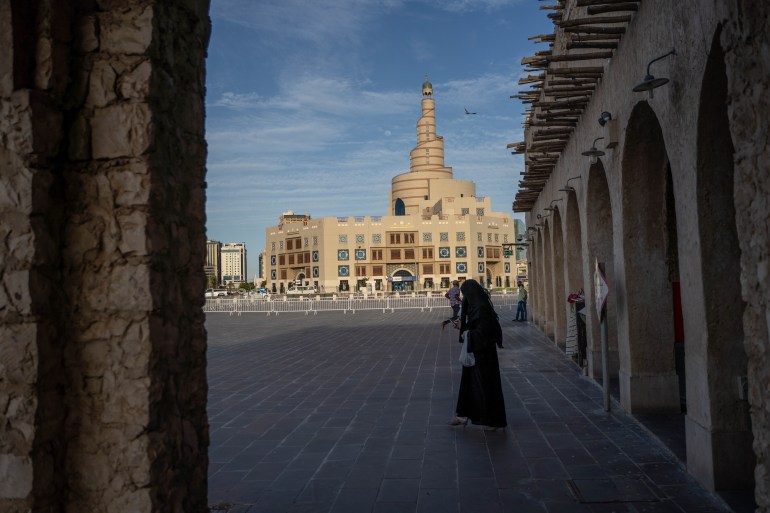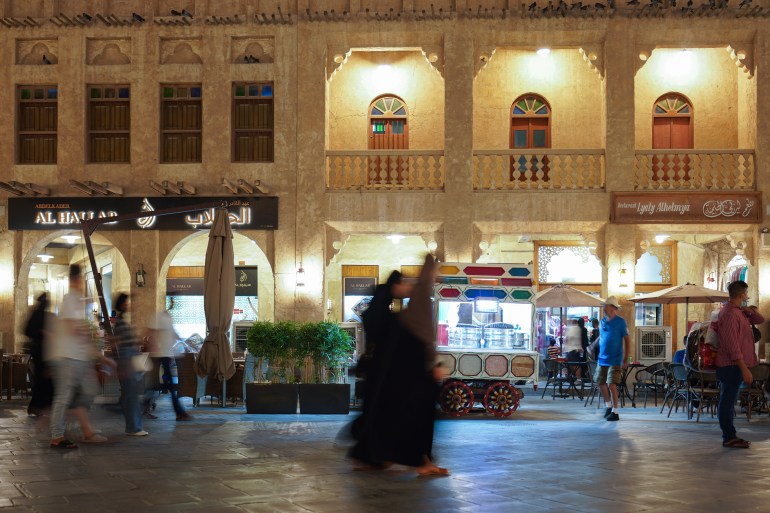The labyrinthine Souq Waqif preserving Qatar’s history, culture
How visitors stand to experience the sights and sounds of coloured spices, a bird market, Arab cuisine and a gold market at Souq Waqif.
![Souq Waqif Doha, Qatar [Showkat Shafi/Al Jazeera]](/wp-content/uploads/2020/12/s22.jpg?resize=770%2C513&quality=80)
Doha, Qatar – With Doha’s dramatic skyline in the background, Souq Waqif, located in the heart of the capital’s old downtown, is a vibrant, labyrinthine market which allows visitors to step back in time to a traditional Arab marketplace.
Hamalis (porters) roam through the narrow, winding alleys with their wheelbarrows, some carrying shoppers’ purchases, others looking for customers.
Keep reading
list of 4 items‘Adrenaline rush’: How street cricket has evolved in Qatar
Qatar World Cup 2022 explained in maps and charts
Shell buys stake in Qatari gas field expansion project
The elderly enjoy a game of dama (backgammon) in the Majlis al Dama. For the younger generation, there are the toy shops, bird market and the sight of pigeons picking up the grains spread casually across the outer grounds.
There are the exotic smells of saffron, cloves and cardamom in the air, the sight of sparkling gold and precious metals fashioned into the most stunning pieces of jewellery.
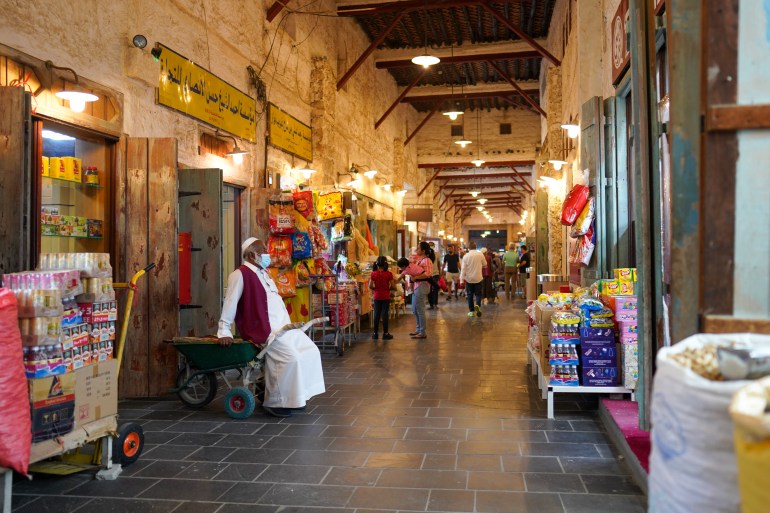
Founded more than a century ago, Souq Waqif was once a weekend trading hub on the banks of the Msheirib wadi (river) to facilitate trade between nomadic Bedouin and the locals.
Waqif, “standing” in Arabic, relates to merchants and residents who would do their dealings standing up due to the overflow of seawater on both sides of the Wadi, which had poured into the market.
“Not a single shop was built during the pioneering period, and Doha’s corniche was only a short distance from the souq, until developers began turning the water’s edge more into land,” Shams al-Qassabi, the first Qatari woman to open a business in the Souq Waqif in 2004, told Al Jazeera.
The weekly market soon became an important location not only for trade but also information and news, contributing to the transfer not just of tangible goods but the expansion of knowledge.
“It was not only an important site for trade, but also for social life. It was where the community would come to know the latest developments, both local and international,” she added.
Raised in the Al Jesra neighbourhood, adjacent to Souq Waqif, al-Qassabi witnessed her father, uncles and extended family members’ business became rooted in this traditional marketplace, duly noting their emotional ties with the place.
“I consider Souq Waqif a vital part of my and my ancestors’ lives since I grew up in its alleyways, surrounded by its beauty and all the charm it has to offer.”
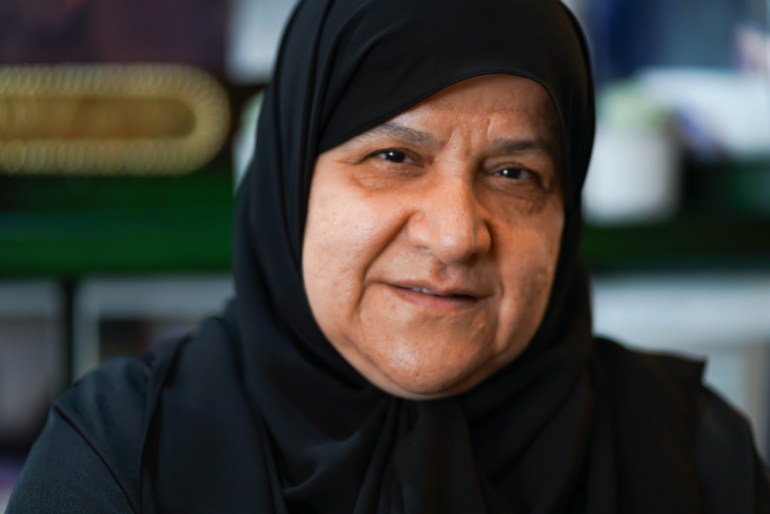
She has witnessed not only the physical transformation of the souq but also the social changes taking place.
Following in her father’s footsteps, and with an aim of helping her retired husband, she took a bold initiative to break down the gender stereotypes holding back women entrepreneurs in the male-dominated souq and opened both a spice shop and a restaurant known as Shay Al Shoomos.
“Women visiting the souq were not appreciated by society at the time. So the fabric-selling merchants would carry a basket called a boksha door to door, crying out to encourage women to purchase their goods.”
With the discovery of oil and the expansion of the oil industry in the 1950s, Qatar’s economy was dramatically transformed and Souq Waqif thrived accordingly.
But the boom in prosperity from the 1960s to the 1990s also saw a huge expansion of the shopping mall environment and, as a consequence, Souq Waqif’s popularity and footfall went into a decline.
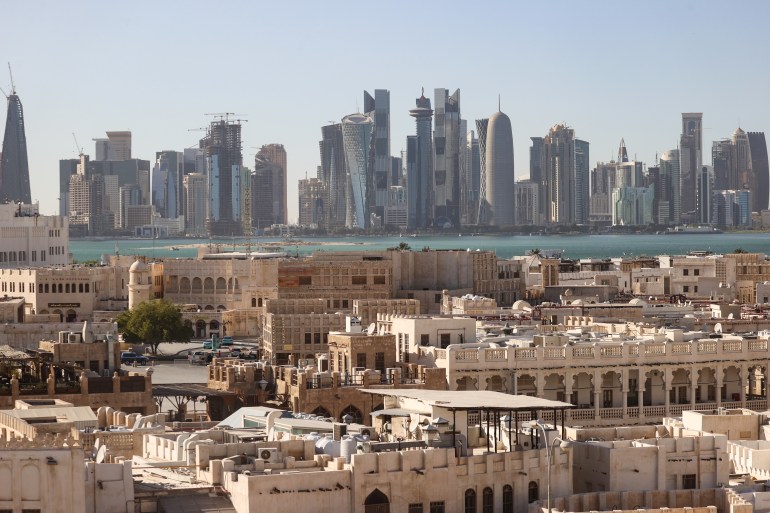
In 2003, most of the souq was destroyed by a fire.
As Doha cityscape began to change, and realising the catastrophic loss of tradition, Qatar’s emir commissioned renowned Qatari artist Mohamed Ali Abdullah for a new souq based on the appearance of the old one.
A narrative storyboard was created after discussions with builders and artists. Abdullah supervised the production of a series of drawings that illustrated the everyday living practices of Qatari people.
Coupled with the knowledge of skilled craftsmen to create a new vision for the souq, work began from 2004.
Modern buildings were replaced with traditionally built roofs of dangeal wood and bamboo with a binding layer of clay and straw, and strategies to insulate the buildings against extreme heat were re-introduced.
Upon completion, a cultural and historical phenomenon was recreated.
Fast-forward all those years, stepping into the winding, maze-like passages of Souq Waqif is almost like stepping back in time.
“Apart from local customers, I receive many tourists daily. Some come to enjoy the traditional flavours of the spice souq, while others take home their pick from the colourful sacks of spices and herbs for family and friends,” Muhammad Abul Kalam, who has traded spices and herbs at the Muhammad Sadiq Ali Akbar store for more than 30 years, told Al Jazeera.
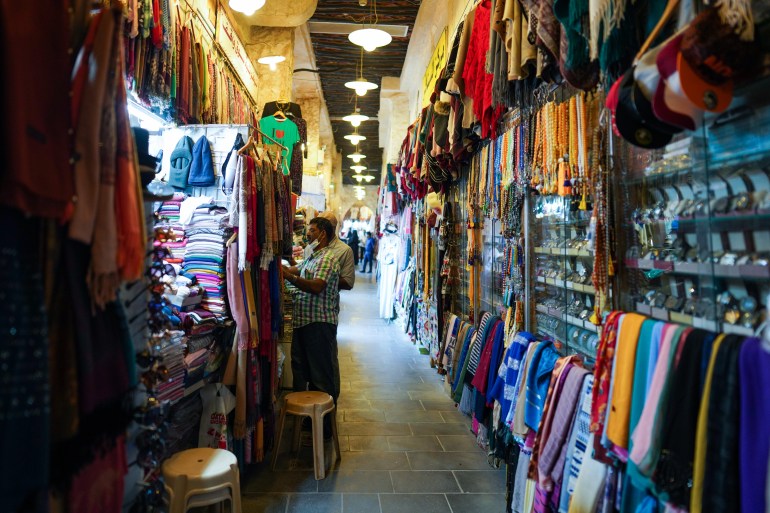
Other options include carved wooden objects, trinkets and pillboxes crafted in wood and silver, wide selection of coffee and dates, or even large, expensive traditional items such as carpets and rugs.
As Qatar World Cup 2022 approaches, many stores in the souq, especially the souvenir places, are bracing themselves for an influx of tourists and, as a result, a healthy cashflow.
KP Musammil, who works at Khor Aladid Ancient Art, is one of them, hoping for a boost in football-related sales.
“Every day, there are quite a lot of tourists here. However, during the World Cup, I hope there will be at least three times, if not more.”
Nasirul Rain, who works at Esfahan Gallery, has not visited his native Nepal in a long time but is postponing the trip until after the World Cup.
“We want to leave World Cup fans with a lasting memory of Qatar by impressing them with something unique that they cannot find in their own country,” he told Al Jazeera.
“We have hand-knitted Persian carpets but the Sadu weaving ones are something particularly regarded as a perfect example of a traditional Gulf cultural product. Tourists and Arab visitors are eager to purchase them as mementos of Qatar’s cultural heritage,” Rain added.
In addition, the souq offers a vast array of restaurants and eateries catering to all tastes including Iraqi, Egyptian, Lebanese, Syrian, Indian, Azerbaijani, Yemeni and Qatari among others.
Two olfactory pleasures that are hard to resist are the delectable aromas of bread baking in a taboon (clay oven), or the smell of smoky kebabs sizzling on an open charcoal fire.
![Souq Waqif Doha, Qatar [Showkat Shafi/Al Jazeera]](/wp-content/uploads/2021/04/6N0A0080.jpg?w=770&resize=770%2C513)
Freshly fried hot falafel completes the scent of true authentic Arabian cooking.
For a more flamboyant and exciting entertainment, there is the Falcon Souq, where a direct glimpse into the past can be obtained via this ever-popular sporting tradition.
More than a dozen falconers are operating specialised shops here, providing a wide range of popular falconry products and hosting falcon tours to gain a deeper knowledge of falconry as a sport and cultural tradition.
“The price of a falcon starts from 2,500 Qatari riyals ($685) and can go up to a few hundred thousand riyals, depending on the type and breed. The majority of our customers are Qataris, Saudis and Kuwaitis,” Mohammad Islam, a representative of Al Ghizlaniyah Falcons & Requires that has been in trade for more than 30 years, told Al Jazeera.
Next door is the Souq Waqif Falcon Hospital, boasting clinical facilities large enough to treat up to 130 birds during peak season.
With the presence of an art centre, highlighting traditional Islamic and modern Arabian art, the area rounds off offerings to cater for all sorts of visitors as a cultural and historical nexus between the past and the present.
